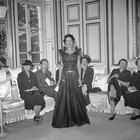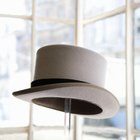
In the 1920s, the status of women was changing politically and socially. Often referred to as the Roaring Twenties, the 1920s saw the emergence of a new type of woman, the flapper. According to Arena Stage, "the flapper became the symbol of a youth movement that championed new ideas about womanhood and appropriate female behavior."
History
The flapper's short hair style evolved over the decade of the 1920s. Arena Stage explains that "in previous decades, the Gibson Girl, with her long luxurious hair, her hourglass figure, and elegant tailored gowns, had been the model of femininity." In direct opposition to their mothers, women cut off their hair in favor of a more boyish look, playing with notions of femininity.
Types
Fashion-Era.com chronicles the hairstyles of the flapper in the 1920s. In 1922, women cut their hair into a bob where hair fell below the ears. In 1925, flappers favored the shingle haircut, where hair was cut very short at the back of the neck and covered their ears. Though the image of Josephine Baker's Eton cropped haircut comes to mind when people think of the conventional flapper, that particular hairstyle did not emerge until approximately 1926, according to Fashion-Era.com. As the decade went on, the flapper's hair got shorter, amplifying the shock value and pushing the lines of androgyny and sexuality.
Time Frame
In the 1910s, women suffragists were gaining the right to vote in countries all over the world. According to the BBC, women were given the right to vote in 1913 in Norway in 1913, in 1917 in Russia and in 1918 in Germany. Women in Britain participated in their first election in 1918. Arena Stage chronicles that, in 1920, the 19th Amendment was ratified and American women were given the right to vote. The new-found independence of women sparked the life of the flapper that became the style of the 1920s woman, and the short hairstyle was a symbol of that liberation.
Misconceptions
The flapper has been notoriously criticized for her promiscuity and willingness to talk about her sexuality. According to Arena Stage, "one of the most significant ways that young women in the 1920s distinguished themselves from their Victorian counterparts was in their attitudes about sex. Flappers were educated about sex and had no qualms about discussing it openly in mixed company." The change in attitudes from their predecessors is reflected in the women of the 1920s cutting their hair and changing the style of the day. It was a natural progression in female fashion and a celebration of independence rather than corruption.
Significance
The short haircut was not only a fashion statement, but a political one as well. Arena Stage states that "after the Great War, young women were unwilling to return to traditional female roles and resubmit to strict Victorian morality." The shedding of the long hair that the women generations prior to theirs had prized was, in essence, a shedding of the Victorian morality and traditional female roles. The flapper continued paving a new path for women that was founded on the liberation of the women's suffrage movement that had achieved so much the decade before.
Related Articles

Beards of the 70s

Wedding Dresses of the 1920s, 1930s & ...

Black Hairstyles of the 1800s

Facial Hairstyles in the 1960s

Carol Gilligan's Theory of Gender & ...

The Impact of Petrarch

What Type of Clothes Did Women Wear ...

Who Invented Hair Weaves?

Facts on Natural Hair Changing Color

Hat Trends of the Seventies

Teens Dealing With Jealous Boyfriends

History of Body Waxing & Hair Removal

Women's Hats in the 1700s

The Importance of Father Figures

Children's Clothes in 1910

Victorian Hairstyles for Men

The Significance of Earrings on Men

1930s Hairstyles for Men

The Short Women's Haircuts of the 1940s

What Were Popular Hair Colors in the ...
References
Writer Bio
Born in Kingston, Jamaica, Chanelle Sicard completed her B.A. in honors English from McMaster University at the age of 20. Sicard has been writing professionally since November 2008, has a chapter published in "Universal Healthcare Problems in the United States of America," and has written for Poshglam.com, SweetSpot.ca Inc., and "Broadway Magazine."
Photo Credits
she is a flapper image by David Levinson from Fotolia.com